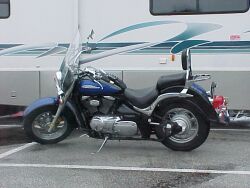 Bike
Week 2003: Rain Rain Go Away. If Not, We'll Ride Anyway Bike
Week 2003: Rain Rain Go Away. If Not, We'll Ride Anyway |
by Bob
DelPriore
Associate Editor
Beginner Bikes Magazine
Bike week is always fun
but it would have been nice to see the sun. We spent 10 days in
the Sunshine State and got rained on 8 of those days. One thing
I had time to work on were my wet riding skills. So I'd like to
share some tips that will help you keep the rubber side down when
it rains.
 Wear
The Right Gear Wear
The Right Gear |
 Even
in temps that started out in the high 70s it got pretty cold once
the rains came. On one ride the temperature dropped about 15 degrees
in a matter of 2 minutes. Apparel designed to keep the wet out
while allowing proper ventilation will make your ride much more
enjoyable. Without rain pants my jeans felt like they weighed
40lbs when wet. Even
in temps that started out in the high 70s it got pretty cold once
the rains came. On one ride the temperature dropped about 15 degrees
in a matter of 2 minutes. Apparel designed to keep the wet out
while allowing proper ventilation will make your ride much more
enjoyable. Without rain pants my jeans felt like they weighed
40lbs when wet.
A full face helmet will keep you dry. The rain can really sting
against your chin so an open face might not be the best choice.
You can open the face shield a bit if your full face fogs. There
are also some excellent after market accessories like the Fog
City Fog Shield that help with this problem.
But if you are caught with an open face helmet you can use a bandana
around your mouth and chin to stop the painful pelting of the
rain.
You might be tempted to tie some plastic trash bags around your
boots. They will work until they start to melt against hot engine
parts and pipes.
 Inspect
Your Bike Inspect
Your Bike |
Just like every other ride, the pre-ride inspection is important.
Pay particular attention to the tires. Worn or improperly inflated
tires can not channel water away as well as designed. Make sure
there is no exposed electrical wiring. And the clutch and throttle
should operate smoothly.
 Practice
Riding In The Rain Practice
Riding In The Rain |
Don't wait until you have to ride in the rain. Pick a day and
a practice area. Test your braking, acceleration, lean, vision,
and be smooth. For the most part you should use the same techniques
you do when it's dry. Just ride a little slower, lean a little
less, and allow a little more room.
Accelerating:
Everything should be as smooth as your skills permit. You
don't have to crawl off the line. Just be smooth and maintain
a consistent acceleration. Don't play games like trying to
fishtail from a traffic light. You could end up facing rear
and really looking silly.
Turning:
Assume you will have between 70% and 80% of your normal traction.
You can lean the bike without any fear. Again the secret is
to remain smooth. Reduce your normal entrance speeds. This
will allow you to turn with a little less lean. Don't forget
to get off the brakes before you start to lean. While turning
continue to add throttle in a smooth and controlled manner.
Never brake while leaned over in a wet turn. Before you increase
to exit speed make sure the bike is no longer in a lean.
Braking:
Allow extra room for stopping. Visibility will be poor and
there might be some loss of traction. Braking should also
be a smooth gradual increase of pressure. Be alert at lower
speeds. Brakes can get a little grabby when wet. Engine compression
will slow you and prevent wheel lock up when the speeds and
gears are matched properly. Just be aware of the traffic behind
you. They won't see brake lights and might get a little too
close for comfort before they realize you are slowing.
 General
Advise General
Advise  |
- Don't ride
in conditions you are not comfortable with.
- Stay in
the car tire tracks ahead of you. They will push a significant
amount of water out of your path.
- Roads are
designed with a slope to allow water to run off. At times the
water collects at the edges of the road. Avoid the outer edges
of the road. Hitting some puddles can cause you to lose control.
It can also force more water up your pants leg then a fire hose.
I know this feeling first hand.
- Get
off the road for the first 15 minutes of any rain.
Water
pushes oil up from the pores of the road. You should wait for
the rain to then wash the oil away before proceeding.
- If you
notice a change in the sound of the tires slow down without
braking. This could be an indication of hydroplaning. The change
in sound could be caused by the tire's inability to maintain
contact with the road.
Rain
should not be feared. However, it deserves a large helping of
respect. No matter how well you plan you will get rained on some
day. Once you have developed confidence in the rain you might
find yourself praying for it on a few summer days.
Here's looking forward to spring's riding season and the showers
that go along with it. Ride Safe! |

